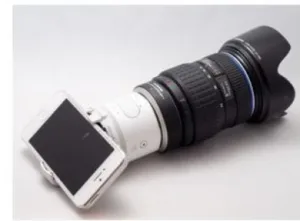The Olympus Air A01 looks like it is just a lens but it is actually an add-on camera for Android or iOS smartphones. The camera does not have its own display but, rather, uses the display on the associated smartphone. More than that, the camera is controlled by an app that is downloaded into the smartphone.

The Air A01 is wirelessly-connected to the phone by either Wi-Fi or Bluetooth. By adopting this configuration, Olympus has combined the benefits of a camera having interchangeable lenses, such as optical zoom, narrow depth of field, good image quality and good low light performance,with the capabilities of a smartphone.
A video at the end of this article includes a presentation on the configuration and capabilities of the Olympus Air A01.
The Air A01 measures 56.9 x 57.1 x 43.6 mm and weighs 147 g. It can be clipped to a smartphone using a holder available with the Air A01. When fully charged, the camera’s built in Li-ion battery is reported as enabling the capture of up to 320 images.
The Air A01 features a Micro Four Thirds lens mount. This gives the camera access to the 20+ currently available Olympus M. Zuiko lenses. The camera also includes a 16 megapixel Live MOS sensor (17.3 x 13 mm). This corresponds to a native 4/3 aspect ratio although capture in other aspect ratios is possible. The Air A01 includes a TruePic VII image processor. This set of hardware enables burst speed shooting at 10 fps and an ISO range between 100 and 12,800. It is possible to record up to 29 minutes of Full HD 1080p video at 30 fps. Still image capture in JPEG (with resolution between 640 x 480 and 4608 x 3456) and RAW (with a resolution of 4608 x 3456) are also possible. The mirrorless Air A01 includes an electronic shutter with speed from as short as 1/16,000 second to as long as 4 seconds. The Air A01 includes image stabilization.
The Air A01 software is an open platform. This means developers can produce their own apps for the smartphone (or tablet) to control the camera using an SDK available from the company. Using the same resources, it is also possible to design accessory products.
The Air A01 software allows manual focusing. There is also an auto focus mode that is based on an 81 point system. By tapping the touchscreen on the smartphone, it is possible to adjust settings such as exposure, white balance, aspect ratio, ISO speed and to apply filters. The app can be used to access to the same P, A, S and M modes as found on conventional SLR cameras. There are also customizable buttons that allow the user to set up the interface as desired.
The Olympus Air A01 can store images and video on a microSD card. Images can also be automatically uploaded and stored on Amazon Cloud Drive or a variety of social media sites.
The “OA Central for Olympus Air” app offers a variety of shooting features including:
- Art Filter – offering several image “looks” including Vintage, that uses muted tones, or Pinhole that adds vignetting around the subject.
- Color Creator – allows enhancement of specific colors within an image.
- Photo Story – enables capturing a scene from several viewpoints.
- The Genius function – initiates the production of six different variations of every photo.
- The Clips function – provides video editing capabilities such as rearrange snippets, the addition of transitions and/or background music and the application of creative art effects.
It can be noted that the Air A01 camera can be used even when not attached to a smartphone. This feature might be useful in situations, as an example, in which it is inconvenient to use a traditionally shaped camera. In such use, the camera automatically knows the angular orientation of the longitudinal axis of the cylindrical shaped Air A01 device. Although physically separated, the camera is still controlled by the smartphone and the image is still presented on the smartphone display. The Air A01 incorporates provision for mounting on a tripod which could be useful for remote photography.
Up to now, the Air A01 has been available only in Japan. Starting this month, it will become available in the U.S. The price will be $300 for the body alone or $500 when bundled with a 14 – 42 mm EZ lens. -Arthur Berman

